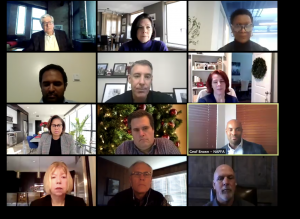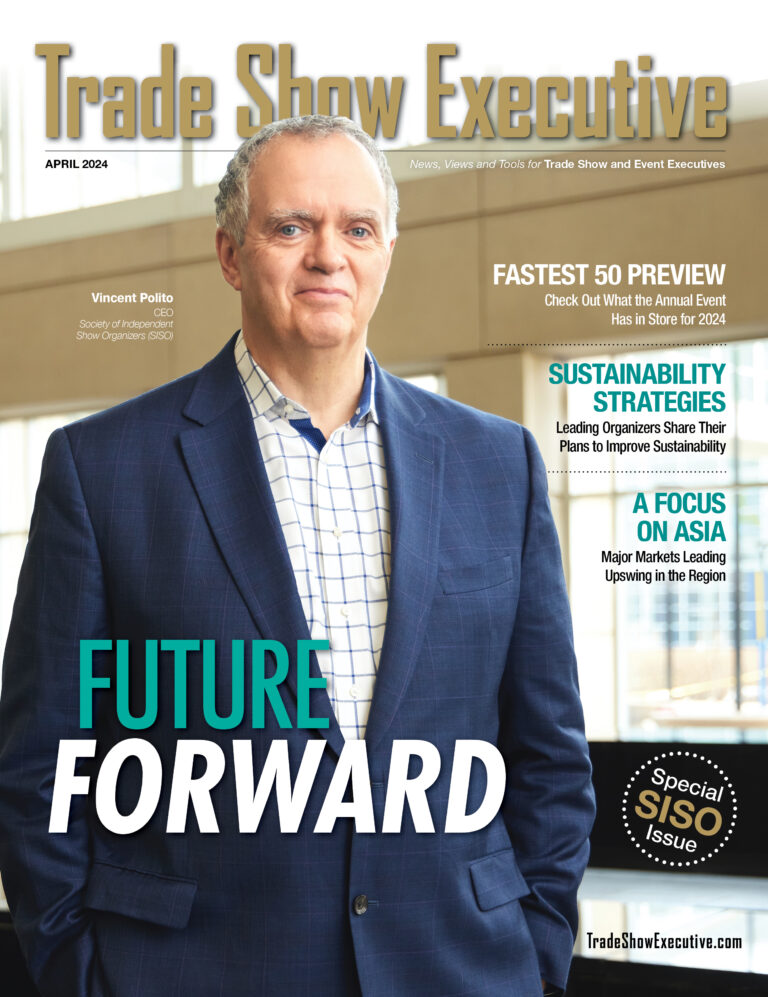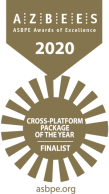 At a recent online town hall, the Association Forum and the Meetings Mean Business Coalition (MMBC) pulled together an all-star lineup of industry powerhouses to talk about what the future of live events will look like once we get back to meeting in person post-COVID-19.
At a recent online town hall, the Association Forum and the Meetings Mean Business Coalition (MMBC) pulled together an all-star lineup of industry powerhouses to talk about what the future of live events will look like once we get back to meeting in person post-COVID-19.
The events industry is one of many that have been “truly shaken to the core,” said town hall moderator and Association Forum President and CEO Michelle Mason. That’s why, she added, “It’s important for us to have a conversation on what’s happening in our world,” beginning with a quick recap by Caesars Entertainment Chief Sales Officer Michael Massari on MMBC’s focus in recent days, which has been “on securing relief for the industry and, more importantly, gaining permission to operate meetings and events.”
Here are eight top takeaways from the discussion:
- Live events are still happening now — and there’s much we can learn from the safety protocols already in place. John Rissi, Senior Vice President, Operations, PSAV, reminded the panel and the audience that in-person events actually are still happening now, though they are generally small in scope. “From August to November, we executed 16,000 face-to-face meetings,” he said, adding that probably 60% of those were for fewer than 25 people. Citing PSAV’s Meet Safe program, he said, “If we can address the number one concern about how you do it safely, people do want to meet face to face.”
- Live events will be back — but maybe not until Q3 2021. “Nothing excites us more than the prospect of meeting physically in person again, but that’s going to be a while” due to the timing of the vaccine rollout, said Paul Pomerantz, CEO, American Society of Anesthesiologists. Like other associations, his shifted to a virtual format for its 2020 fall annual meeting. He anticipates that early 2021 meetings will also be virtual, with a slow emergence of smaller meetings first, then larger in-person events in the second half of 2021 and into 2022.
- When they do come back, in-person events may be different from what they were pre-pandemic. While his organization’s fall 2021 meeting likely will be able to go on as an in-person event, it may be “not at the size we’re accustomed to,” said Pomerantz. Having learned from experience in going virtual just how much that can expand a meeting’s reach, especially internationally, look for future events to contain a hybrid component, panelists said. Not to worry, including a virtual component should only increase the attractiveness of in-person events, he added. “They will have multiple pathways for the education, but the real opportunities of networking, connecting with people and building their careers is going to happen at the live event.” Massari added, “We should embrace hybrid because it broadens the tent. It’s a great funnel for in-person events.”
- Hybrid events aren’t easy. As one panelist said of a recent virtual event her organization held, “It was heavy, heavy lifting.” Staff has to learn new skills and master new technologies, go outside their comfort zones, and put in a lot more hours. Fine added that the two virtual events his organization has held recently “were so much more work than we have done in person — and without a lot reward of seeing our members enjoy the experience and celebrating together. We’ve made a lot of advances, but it’s been quite the ride.” Pre-recording at least some sessions can help, as can thinking about making two totally separate educational tracks, one for on-site and another for online.
- Online trade shows still need some work. “Our exhibits at the virtual event were the only aspect that was unsuccessful,” said one panelist. “It was a very vibrant meeting, but nobody went to the exhibit hall.” What did work was to have exhibitors sponsor sessions.
- What to charge for online events? One important issue to hash out is pricing for the virtual component, panelists agreed. While many made their online events free in 2020, that won’t make sense moving forward. “Now is the time for us to begin to really think about how our entire business can shift. What is commoditized, and what is really valuable?” said Greg Fine, CEO, CCIM Institute. One panelist proposed charging the same for the online sessions as for the in-person education.
- Flexibility will be key. Associations, which tend to book years in advance, have to figure out new ways to plan appropriately, said Betsi Roach, Executive Director, Corporate Legal Operations Consortium. The assumption when the meeting was booked was that the audience would only grow, and that may no longer be the case. “How do you start to readjust those expectations in a way that keeps both of us whole and also lets us plan effectively for what the meeting will look like now?” she asked. Not only will the audience likely be smaller, but will social distancing still be an expectation, and how will that affect how the meeting is structured? “There is going to be really critical need to address existing agreements in a way that allows those changes to happen,” she said. Partners will need to work with association execs to be flexible enough to accommodate changing conditions, which also could include attendees’ corporate travel bans.We need to do away with the silliness of 2020, where each side ended up playing a game of chicken to see who would cancel first, with the association having to pretend the event is going to happen up until the last minute to avoid cancellation liability. Fine reminded that hotels also are in a tough situation, especially those with mortgages coming due — and cities are hurting due to the slow-to-a-trickle hotel tax revenues the pandemic has caused. Flexibility, transparency and communication on both sides are going to be essential moving forward, panelists agreed.
- Plan for every possible contingency. “As leaders, you need to plan for every contingency, and that’s exhausting,” said Greg Heidrich, Executive Director, Society of Actuaries. “We’re also still trying to run our businesses and keep our staff safe and keep our staff and our own morale up. But if you don’t actually game out every possible scenario, then you’re going to be reacting. And we’ve got to get back to being proactive.”











